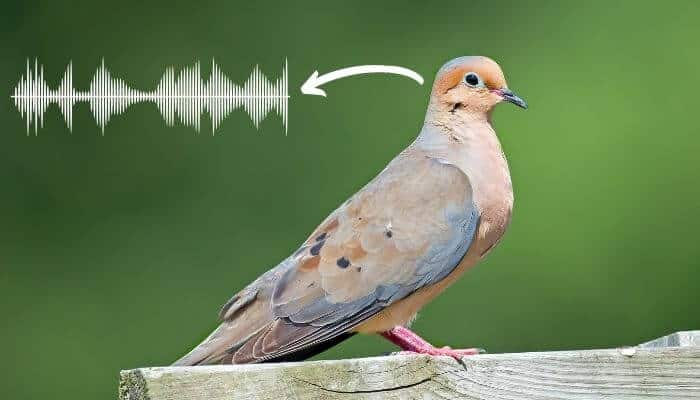There are three sounds associated with the mourning dove:
- The song or perch-coo
- The nest call
- The take-off whistle

The Mourning Dove
One of North America’s most abundant birds, the mourning dove population remains consistently high despite dove hunting accounting for more than 20 million in the USA every single year.
Also known as the turtle dove and rain dove, the mourning dove is able to reproduce even in massive pressure environments and situations. In warmer climates, a single mating pair can raise six broods of two squads per year.
A lot of animals and birds are named or have nicknames that relate to one of the sounds or vocalizations they make.
This is the case for the mourning dove.
The mourning dove gets its name from its main call.
The Three Sounds of the Mourning Dove
Although the mourning dove has a small range of songs and sounds, there are three main ones.
The Song
The main call of the mourning dove is what gives the bird its distinctive and emotive name.
It is an eerie cooing sound that is described as being sad and haunting.
Known as the “perch-coo”, the call is a soft coo-oo followed by a number of short and loud coos – like coo-OO-oo-oo-oo.
You may also be able to distinguish a throat-rattle or grating after the first coo if you are close enough to the bird making the call.
The call is made mainly by perching single males and to the inexperienced ear can sound like an owl call.
The Nest Call
Usually made by males as they build a nest for/with their mate, the nest call is a three-part call of coo-OO-oo. Males may also make this sound to attract females.
On the nest, females often call something that sounds like ohr ohr.
Other vocalizations of the mourning dove are a short roo-oo used as an alarm call and a soft ‘ork’ noise used as a greeting.
The Take-Off Whistle
Not a vocalisation but another distinctive sound, the mourning dove makes a whistling noise when taking off and coming in to land.
This sound may be to warn flock mates that predators are nearby hence the reason for the occurrence at take-off or to startle and scare off predators.
Mourning doves are also able to clap their wings together during take-off, like other breeds of pigeon.
Listen to the three main sounds of the mourning dove here
